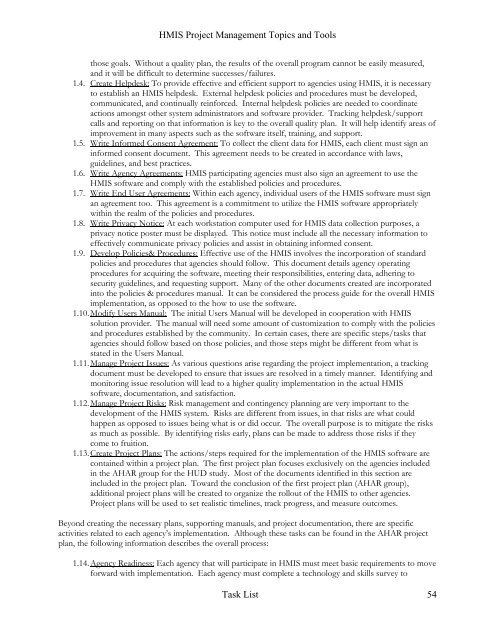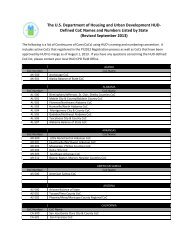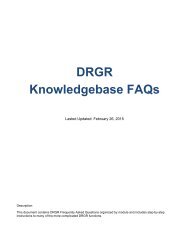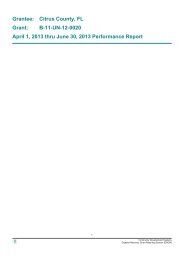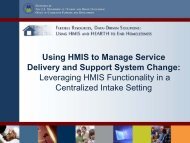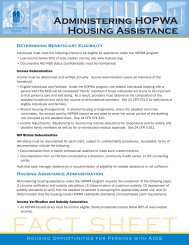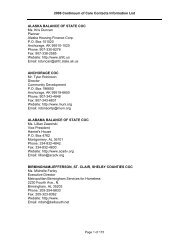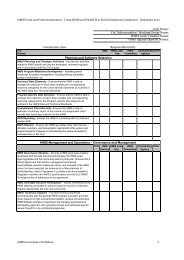HMIS Project Management Topics and Tools - OneCPD
HMIS Project Management Topics and Tools - OneCPD
HMIS Project Management Topics and Tools - OneCPD
- No tags were found...
Create successful ePaper yourself
Turn your PDF publications into a flip-book with our unique Google optimized e-Paper software.
<strong>HMIS</strong> <strong>Project</strong> <strong>Management</strong> <strong>Topics</strong> <strong>and</strong> <strong>Tools</strong>those goals. Without a quality plan, the results of the overall program cannot be easily measured,<strong>and</strong> it will be difficult to determine successes/failures.1.4. Create Helpdesk: To provide effective <strong>and</strong> efficient support to agencies using <strong>HMIS</strong>, it is necessaryto establish an <strong>HMIS</strong> helpdesk. External helpdesk policies <strong>and</strong> procedures must be developed,communicated, <strong>and</strong> continually reinforced. Internal helpdesk policies are needed to coordinateactions amongst other system administrators <strong>and</strong> software provider. Tracking helpdesk/supportcalls <strong>and</strong> reporting on that information is key to the overall quality plan. It will help identify areas ofimprovement in many aspects such as the software itself, training, <strong>and</strong> support.1.5. Write Informed Consent Agreement: To collect the client data for <strong>HMIS</strong>, each client must sign aninformed consent document. This agreement needs to be created in accordance with laws,guidelines, <strong>and</strong> best practices.1.6. Write Agency Agreements: <strong>HMIS</strong> participating agencies must also sign an agreement to use the<strong>HMIS</strong> software <strong>and</strong> comply with the established policies <strong>and</strong> procedures.1.7. Write End User Agreements: Within each agency, individual users of the <strong>HMIS</strong> software must signan agreement too. This agreement is a commitment to utilize the <strong>HMIS</strong> software appropriatelywithin the realm of the policies <strong>and</strong> procedures.1.8. Write Privacy Notice: At each workstation computer used for <strong>HMIS</strong> data collection purposes, aprivacy notice poster must be displayed. This notice must include all the necessary information toeffectively communicate privacy policies <strong>and</strong> assist in obtaining informed consent.1.9. Develop Policies& Procedures: Effective use of the <strong>HMIS</strong> involves the incorporation of st<strong>and</strong>ardpolicies <strong>and</strong> procedures that agencies should follow. This document details agency operatingprocedures for acquiring the software, meeting their responsibilities, entering data, adhering tosecurity guidelines, <strong>and</strong> requesting support. Many of the other documents created are incorporatedinto the policies & procedures manual. It can be considered the process guide for the overall <strong>HMIS</strong>implementation, as opposed to the how to use the software.1.10. Modify Users Manual: The initial Users Manual will be developed in cooperation with <strong>HMIS</strong>solution provider. The manual will need some amount of customization to comply with the policies<strong>and</strong> procedures established by the community. In certain cases, there are specific steps/tasks thatagencies should follow based on those policies, <strong>and</strong> those steps might be different from what isstated in the Users Manual.1.11. Manage <strong>Project</strong> Issues: As various questions arise regarding the project implementation, a trackingdocument must be developed to ensure that issues are resolved in a timely manner. Identifying <strong>and</strong>monitoring issue resolution will lead to a higher quality implementation in the actual <strong>HMIS</strong>software, documentation, <strong>and</strong> satisfaction.1.12. Manage <strong>Project</strong> Risks: Risk management <strong>and</strong> contingency planning are very important to thedevelopment of the <strong>HMIS</strong> system. Risks are different from issues, in that risks are what couldhappen as opposed to issues being what is or did occur. The overall purpose is to mitigate the risksas much as possible. By identifying risks early, plans can be made to address those risks if theycome to fruition.1.13. Create <strong>Project</strong> Plans: The actions/steps required for the implementation of the <strong>HMIS</strong> software arecontained within a project plan. The first project plan focuses exclusively on the agencies includedin the AHAR group for the HUD study. Most of the documents identified in this section areincluded in the project plan. Toward the conclusion of the first project plan (AHAR group),additional project plans will be created to organize the rollout of the <strong>HMIS</strong> to other agencies.<strong>Project</strong> plans will be used to set realistic timelines, track progress, <strong>and</strong> measure outcomes.Beyond creating the necessary plans, supporting manuals, <strong>and</strong> project documentation, there are specificactivities related to each agency’s implementation. Although these tasks can be found in the AHAR projectplan, the following information describes the overall process:1.14. Agency Readiness: Each agency that will participate in <strong>HMIS</strong> must meet basic requirements to moveforward with implementation. Each agency must complete a technology <strong>and</strong> skills survey toTask List 54


